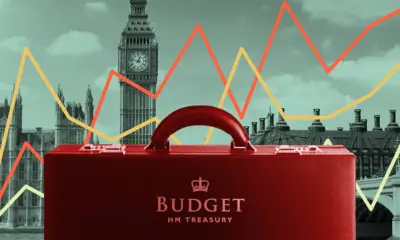Business
UK Business Output Declines Amid Slower Consumer Spending and Services Activity

Introduction
UK business output weakened in the third quarter of 2025 as consumer spending slowed and services activity softened, signaling that high borrowing costs and persistent inflation are taking a toll on economic momentum. According to the latest Purchasing Managers’ Index from S&P Global and CIPS, the composite index fell to 49.8 in September, dipping below the critical 50 threshold that separates expansion from contraction. The data marks the first contraction in overall business activity since early 2024, driven primarily by reduced consumer demand and a cooling service sector. London, home to the UK’s largest concentration of financial and professional services, remains more resilient than regional markets but is not immune to the broader slowdown.
Market Overview
The UK economy has entered a period of subdued growth as the effects of tighter monetary policy ripple through businesses and households. The Bank of England’s base rate, maintained at 5.25 percent, has significantly raised financing costs for firms. Business surveys show that companies across retail, hospitality, and construction are experiencing weaker sales volumes as consumers cut discretionary spending. The services sector, which accounts for roughly 80 percent of GDP, saw output decline 0.2 percent in August compared with the previous month. Meanwhile, manufacturing remained stagnant, with export demand dampened by a strong pound and global economic uncertainty.
Data from the Office for National Statistics shows that GDP growth in the second quarter of 2025 was just 0.1 percent, with private consumption contributing minimally. Inflation, although easing from its 2023 highs, remains above the Bank’s two percent target at 3.1 percent. Persistent price pressures in services, transport, and housing continue to erode household purchasing power. The slowdown in real wage growth, coupled with elevated living costs, has resulted in cautious spending patterns. Retail sales volumes have fallen 1.4 percent year-on-year, highlighting the strain on consumer-facing businesses.
Policy Insight
The Bank of England’s monetary stance remains focused on maintaining price stability despite rising concerns about growth. Governor Andrew Bailey reaffirmed that interest rates will stay at restrictive levels until there is stronger evidence of inflation convergence toward target. While this approach has stabilized inflation expectations, it has also tightened financial conditions across sectors. The Treasury, meanwhile, faces limited fiscal space as public debt hovers near 97 percent of GDP. The government’s upcoming Autumn Statement is expected to prioritize productivity measures and green investment rather than direct consumer stimulus.
The Office for Budget Responsibility projects that GDP growth will average just 0.6 percent in 2025 before picking up modestly to 1.1 percent in 2026. Fiscal policy is expected to remain conservative, with a focus on maintaining investor confidence and supporting the gilt market. Economists warn that the combination of high rates and limited fiscal flexibility could prolong stagnation. The International Monetary Fund has urged policymakers to safeguard public investment while targeting inflation through gradual, predictable policy adjustments.
City Response
London’s financial and business community is feeling the impact of the slower economic climate. Investment banks and asset managers report subdued client activity as market volatility and tight liquidity conditions deter new issuance. The FTSE 100 has traded within a narrow range around 7,450, reflecting investor caution. In the corporate lending space, credit growth has slowed to its weakest pace since 2020, with firms prioritizing debt reduction and balance-sheet resilience.
The London Chamber of Commerce noted that small and medium-sized enterprises are particularly vulnerable. Many are grappling with higher input costs and weaker demand while facing challenges accessing credit. Sectors such as retail, catering, and logistics have seen a decline in new business formation. Business confidence indicators remain below the long-term average, with 45 percent of surveyed firms expecting no improvement in trading conditions over the next six months.
However, segments of London’s professional services and technology sectors remain more resilient. Financial consulting, digital infrastructure, and legal services continue to see steady international demand. The city’s diversified economic structure provides a partial buffer against nationwide weakness. Analysts note that London’s global orientation enables some firms to offset domestic softness through overseas contracts and investment flows.
Market Impact
The weakening of business output has broader implications for the UK’s macroeconomic outlook. A slowdown in services activity reduces overall tax revenue and limits wage growth, while lower consumer spending constrains inflation-adjusted GDP. The Bank of England expects unemployment to rise modestly from 4.3 percent to 4.8 percent by mid-2026, reflecting softer labor demand. Despite this, wage growth remains elevated at around five percent, suggesting that inflationary pressures from the labor market have not fully dissipated.
Bond markets have responded to the weaker growth data with modest declines in yields. The ten-year gilt yield fell to 4.12 percent in early October, its lowest level in two months, as investors anticipate a longer pause in rate hikes. Sterling has been stable, trading near 1.24 against the dollar. Analysts suggest that markets are now pricing in the first rate cut in the second half of 2026, contingent on further disinflation.
Corporate earnings results paint a mixed picture. Consumer goods and retail firms report declining sales volumes but improving margins due to cost discipline. Conversely, construction and real estate sectors remain under pressure from high financing costs. The service export sector, including legal and financial advisory, continues to contribute positively to the trade balance, supported by foreign demand for British expertise.
Policy Outlook
Policymakers face a delicate balance between stabilizing prices and avoiding a prolonged downturn. The Bank of England’s monetary framework emphasizes gradualism, suggesting that any future policy easing will be cautious. Analysts expect the MPC to maintain its restrictive stance through at least the first half of 2026. Meanwhile, the Treasury’s policy direction will focus on supply-side reforms aimed at boosting productivity and supporting long-term competitiveness.
The government has announced several initiatives to enhance business resilience, including expanded digital infrastructure funding and support for green technology startups. These programs are designed to stimulate private investment in strategic sectors rather than rely on short-term consumption. London’s role as a financial hub remains central to these ambitions, with the City expected to play a key role in financing sustainable and digital innovation.
Outlook 2026
Economic forecasters anticipate a slow but steady recovery in 2026. The combination of easing inflation, stabilizing interest rates, and gradual improvement in real incomes could help restore modest consumer confidence. The Bank of England projects GDP growth of around 1.2 percent next year, supported by investment in infrastructure and clean energy. London’s business ecosystem is expected to remain an anchor for the national economy, benefiting from its strong service base and international connectivity.
However, risks remain tilted to the downside. Prolonged weakness in global trade or renewed energy price volatility could weigh on growth. Domestic challenges, including housing affordability and labor shortages, continue to limit productivity. Businesses will need to adapt to a new environment defined by higher structural costs and slower expansion.
Conclusion
The decline in UK business output underscores the challenges of managing inflation while preserving growth momentum. The combination of subdued consumer spending and weaker services activity reflects the lagging effects of tight monetary policy and persistent cost pressures. London’s economy remains more resilient than the national average, yet even the capital’s service-driven model faces headwinds from cautious households and rising operating costs. Policymakers now confront a complex balancing act: sustaining credibility in the fight against inflation without stifling the recovery. For businesses, 2026 will likely be a year of cautious adaptation, where stability and productivity become the key measures of success rather than rapid expansion.




















